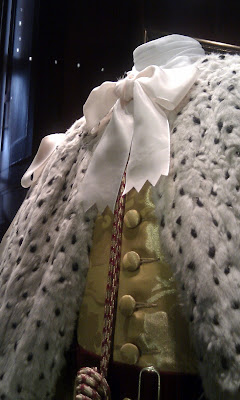 |
| The newly restored Kensington Palace |
I have broadened my research into different kinds of gowns/robes as this is an interesting and varied subject.
I was informed that the newly renovated Kensington Palace has a collection of robes on display and they were not wrong! I last visited the Palace when it was undergoing restoration and so a few rooms were open in an exhibition called 'Enchanted Palace'.
This was interesting as it made me consider exhibition methods in historic houses and what I think is effective in engaging with a public. I think the Enchanted Palace was targeted at girls in particular and was effective at this. Beautiful displays were brought into the rooms to give them a magical atmosphere and it told the history of the Princesses that have lived at Kensington through a kind of mission where the clues were riddles.
 |
| 'Luminous Lace' sculpture in the Entrance Hall |
The council chamber of the Kings State Apartments had been magically reinvented with branches protruding from the walls and stacks of books around the edge, in the centre there was a lady playing cards and talking bizarrely to unsuspecting guests. There are 3 display cases with costumes in, suggesting what would have been worn in these rooms.
Sack-back Court Dress
English
About 1780
White cotton embroidered with gold and silver thread
Possibly worn by Mary Watson Wentworth
Tabard
English
1820
Silk satin embroidered with silk, metal thread, beads, sequins, bullion (precious metal) and semi-precious stones.
Worn by George Harrison Rogers-Harrison Bluemantle Pursuivant Windsor Herald.
Knights Robe
English
1800
Silk velvet with embroidered badge
Cordons - silk and gold thread rope tassels.
Doublet and trunk hose - silver lame trimmed with silver and silk ribbon
Garter - corded silk with motto embroidered in metal thread
Robes of Knight of the Order of the Garter - Reverend Henry Lewis Hobart 1774-1846
Court Suit
English
About 1780
Silk brocade embroidered with metal thread, bullion, sequins and metal foil.
Court Mantua
English
About 1750
Silk brocade
These were beautiful examples of historic garments. I found that through my summer project and independent study I knew a lot more about the style, history and dates of these garments than I had realised. It was interesting to see the mantua on a mannequin. I have seen a few of these in boxes and had not realised how thin they were from the side.
The Knight's robe was most relevant to see for this project. I think I really need to establish all the different kinds of robes from different areas. I know that the colours and fabrics are important to robes but I would like to find out what status these all represent.
Queen Caroline's Closet housed the Kings Coronation robes which were amazing.
Coronation Robes
English
1761
Silk velvet trimmed with gold lace, ermine cape and lining
Worn by King George III
The gold lace that trims the whole of the train
The front of the robe. The top is held together with white ribbon, which are also on the CF to keep the fronts open and on the shoulders, presumably to hold the chain
The robe is lined fully in ermine fur, this is without a doubt a very lavish robe. The court suit is a replica and I assume inspired by the yellow suit worn by the King in the famous Ramsay coronation portrait (See my Ede and Ravenscroft post)
I lastly explored the rooms on Queen Victoria, which included the rooms where she was born, lived in and held her first Privy Council just after learning she was to be Queen at age 18.
It was amazing to see the size Queen Victoria's garments. I find that you can read as much as you like about how small she was but until you see it it is hard to visualise her and how it must have felt to be a female monarch in a patriarchal society.
This is Queen Victoria's wedding dress for when she married Albert in 1840. The rooms are displayed in a very elegant manner, with quotes from her diary pasted all over the furniture and cases to try and create a story as you go around.
2 adorable child's costumes
I thought the rooms on her mourning of Albert were particularly effective at conveying her emotion. Overall however, I found the self guided tour and messages quite confusing. I did not have time to read everything and absorb all the information and this meant that in parts I was a bit lost to what was going on because of the fantastical methods of exhibition and I found it hard to understand why they had put certain exhibits in places as I thought they were not always necessary. I appreciate that they have been a bit different and challenging in how they have displayed the house, but I would have found it beneficial to have a board (nicely decorated to fit with the theme) to just tell me some history of the rooms rather than the riddles or the occasional paper booklet.
I enjoyed soaking up the atmosphere and I thought the palace looked beautiful and the articles on display were of a wide variety and interesting. In particular it was great to see and learn a bit more about the coronation and Garter gowns. Though they were behind cases, you could see the fine sewing and shapes that were created.
















No comments:
Post a Comment